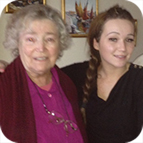Kristis Prior skydived in June to raise money in memory of her Nana. Brave Kristis leapt at the opportunity to do the skydive on 25th June 2013, and here she tells us all about it.
“The 25th June was my 21st birthday and I raised £690.00 for brainstrust’s work, thanks to the amazing support of my friends and family.
I jumped in memory of my Nana who passed away on 4 June this year with a brain tumour. I was very close with my Nana so this hit me very  hard and was a very hard time for me and my family. I wanted to do something to raise money for brainstrust to help people and their families who are going through what we went through.
hard and was a very hard time for me and my family. I wanted to do something to raise money for brainstrust to help people and their families who are going through what we went through.
I miss my Nana so much and will never forget her. I think about her every day and hope she’s proud of what I done and everything I’m doing. I’d also like to thank brainstrust for all the support they gave me and my family since my Nana was first diagnosed with a brain tumour. You really are amazing people.”
It’s always emotional to hear people’s reasons for supporting our work to help people diagnosed with a brain tumour, and their families, and Kristis’s story makes no exception.
To find out more about our work, find out about supporting our work in memory of a loved one, or to get behind one of our projects give us a call on 01983 292405 or email tessa@brainstrust.org.uk
Back in May we ran a little feature about Kristis’s and her Nana click here to read more…








